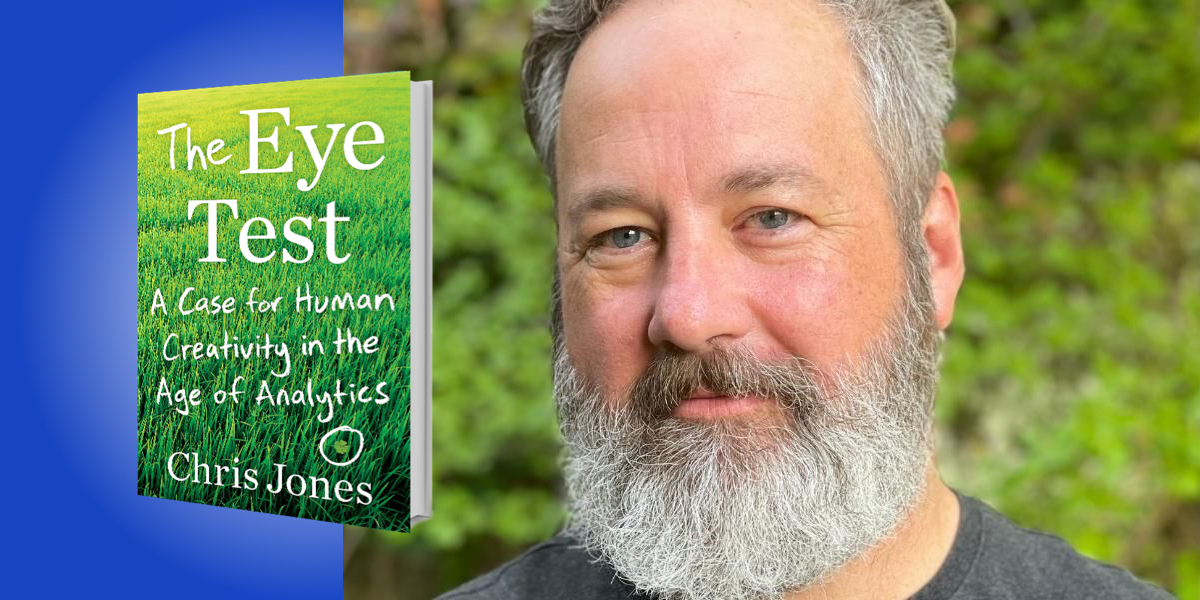Chris Jones, a former writer-at-large for Esquire magazine, has won two National Magazine Awards. He is the author of Out of Orbit and Falling Hard: A Rookie’s Year in Boxing. His work has also appeared in The Best American Magazine Writing and The Best American Sports Writing anthologies.
Below, Chris shares 5 key insights from his new book, The Eye Test: A Case for Human Creativity in the Age of Analytics. Listen to the audio version—read by Chris himself—in the Next Big Idea App.
1. There is no one right way to do anything.
The analytics revolution has led to some seriously black-and-white thinking: that statistical analysis is the only way to find the answers to virtually all of our problems. Sometimes statistical analysis does provide the solution, or at least helps creative thinkers come up with a better solution, but no tool is universal. When a problem is difficult, why would we choose to hold it up to only one light? Why wouldn’t we want multiple points of view?
My older son, Charley, has autism. He’s 15. He loves to read—he carries a huge bag of books with him everywhere he goes. But the spelling of even basic words defies him. That seemed to me an impossible puzzle—how can Charley read without being able to spell?
We’ve since learned that he doesn’t read by sounding out words. He reads by memorizing the shapes of words. To him, written English is like Mandarin or hieroglyphics. He’ll ask us what a word is, and then it will find a permanent place in his titanic memory, the way you can instantly recall the faces of people you know but probably can’t draw them. Being Charley’s father has taught me many lessons. Among them: There isn’t even one right way to read.
“When a problem is difficult, why would we choose to hold it up to only one light? Why wouldn’t we want multiple points of view?”
2. The myth of mathematical objectivity.
Statistical analysis—including AI and algorithms—are often sold to us as objective: “Numbers are binary. Numbers are fact. Numbers never lie.” But numbers are routinely used to deceive, and algorithms aren’t found in nature. They are made by humans, and they contain everything we contain, including bias. This becomes painfully clear when we look at something like facial recognition algorithms.
Hundreds of millions of Americans would be surprised to learn that their faces are already stored in massive databases and, in 2020, Robert Julian-Borchak Williams, an African-American man in Detroit, became the first American arrested after having been wrongly tabbed by a facial recognition algorithm. He was charged with stealing five watches, but it soon became evident to everyone, including the detectives involved, that Mr. Williams bore little resemblance to the actual thief.
Facial recognition works pretty well when identifying white men, but it’s deeply flawed when it comes to identifying people of color, especially women of color. One recent study found that 35 percent of women of color examined by machines were identified as men. Algorithms, like humans, can be highly subjective.
3. A lot of smart people can do the same dumb thing.
If I wrote a book that advocated following the crowd, my TED Talk wouldn’t be very well attended. Competitive advantage is achieved only by doing something better or differently than everyone else. But right now, armies of smart people are offering the same solutions, but slightly tweaked: better math, better nerds, better access to better data. Because of the pervasiveness of analytics—increasingly the one way of doing things—I believe there’s a real opportunity right now for creative people to do singular work, often using old methods.
“Your knowledge, your experience, is a supply of one, and there is limitless demand for it.”
Graphic design is a cool example. Most logo design gets watered down by focus groups, analyzed into mediocrity. But take something like the iconic, gorgeous logo for the Hartford Whalers hockey team. It was drawn by hand by a man named Peter Good, who used years of skill and experience and artistry to summon perfection, and he was left alone to do it.
The analytics movement has done a really good job of making industry veterans feel like their hard-won knowledge has no value. Yet it has incredible value—your knowledge, your experience, is a supply of one, and there is limitless demand for it.
4. The pursuit of “embodied analysis.”
I’m not making the case for gut sense. My gut would often prove useless, because I don’t have any wisdom when it comes to a host of situations. Trust your gut when it comes to physical danger—if your body is telling you to run, I hope your feet don’t fail you—but we should all be working toward a kind of intellectual muscle memory: when practice and experience combine to give us an almost instantaneous understanding of what’s happening and what should happen next. Not innate understanding, but earned understanding.
“When a ball would leave the bat, Clemente would turn his back to it, run to the spot where he knew it would fall to Earth, turn, and wait for the ball to meet him.”
Burkhard Bilger of The New Yorker wrote a beautiful story about a carpenter named Mark Ellison. Bilger saw Ellison do something remarkable with a table saw, a machine designed expressly to make straight cuts. Ellison was using it to make intricate, curved cuts, all while chatting away with an apprentice. Bilger said something about it, and Ellison told a story about Roberto Clemente, the Hall of Fame outfielder. When a ball would leave the bat, Clemente would turn his back to it, run to the spot where he knew it would fall to Earth, turn, and wait for the ball to meet him. Time had given Ellison the same understanding of wood’s introduction to his spinning blade. Bilger called that seamless, transcendent drive toward perfect action—that elusive flow state—“embodied analysis.”
That’s not just “gut.” That’s a knowledge so deep it feels almost physical. That should be our goal.
5. The adaptability advantage.
Data-mining only works if the future behaves like the past—that’s how numbers are “predictive.” Sometimes that’s the case, but history doesn’t always repeat, and that’s increasingly true today. No mainframe in the world would have predicted the arrival of COVID, or known how to respond to it.
Another example is the weather. Climate is extreme, and our weather models don’t know how to deal with such extremes. They had never encountered anything like the rainfall forecasts for Hurricane Harvey. During 2020’s horrific wildfire season, Washington state’s air-quality measuring instruments dismissed their own readings as incorrect. But they were, in fact, accurate.
Only humans, using our limitless imagination, are able to accept, and predict, a previously unseen reality. Right now, perhaps more than at any other time in history, our imaginations are the only instruments on Earth capable of understanding what might come next. Machines can’t self-correct—only we can. It is time for us to shine.
To listen to the audio version read by author Chris Jones, download the Next Big Idea App today:































